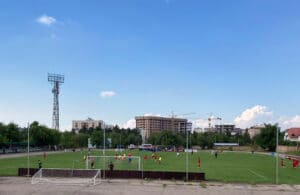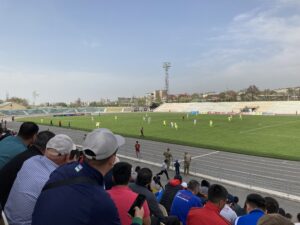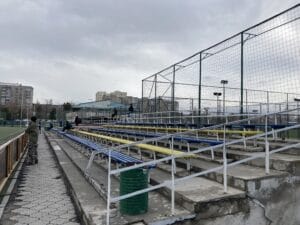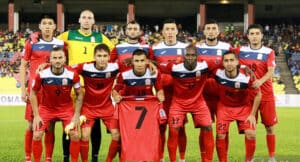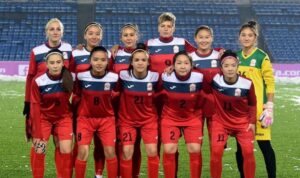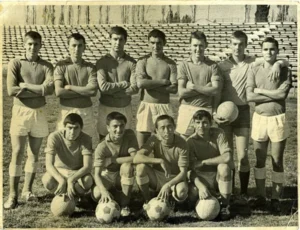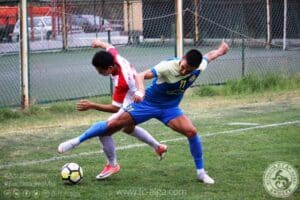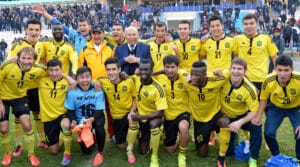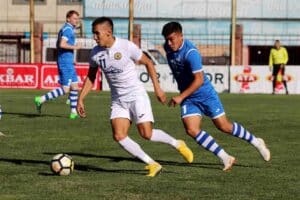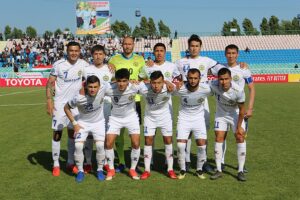The history of soccer in Kyrgyzstan goes back to 1921, with an oft-cited first match taking place in Bishek, Kyrgyzstan’s capital city, against a team from Kazakhstan. The Kazakh team won, but not before the sport of soccer staked a permanent claim on the Kyrgyz national consciousness— the game’s been culturally significant ever since.
However, in the world of soccer, small teams tend to lose to big teams. The team with the deeper pockets can poach the best talent from a team with fewer resources. In the global soccer world, this also means that small countries with less developed economies tend to lose their best players to teams from countries with larger economies. Thus, Kyrgyz soccer has struggled for many years. However, many SRAS students in Kyrgyzstan have enjoyed attending their games, seeing their ultras cheer for teams that play with an abundance of heart.
Thus, Popkult has compiled, with the help of a number of student writers and Online Research Interns, the following introductory guide to Kyrgyz soccer.
Introduction to the Kyrgyz Premier League
By Ben Bullock and Ellie Kline
Organized and run by the Kyrgyz Football Union, the league played its inaugural season in 1992, taking over from the soviet-era Kyrgyz SSR Football Championship. Since then, the competition has been at the forefront of Kyrgyz soccer and provided most of the talent for the country’s national squad.
During the Soviet era, Kyrgyzstan was one of only two republics never to have a team compete in the Soviet Top League. In fact, only one team ever got close. In 1967, FC Alga Bishkek finished third in the Second Division, one point short of promotion into the uppermost echelon of Soviet soccer. No Kyrgyz team would ever again reach those lofty heights, and by 1991 the two best respected Kyrgyz clubs, Alga and FC Alay Osh, were playing in the Soviet Third Division.
Some sportswriters attribute the early slow and incomplete growth of the sport in Kyryzstan to a lack of infrastructure for the sports industry there at the time— the funding and fanbase necessary for a successful team were simply not yet in place. The biggest bump to Kyrgyz soccer came, oddly, in the form of World War II; an influx of evacuees from the Western Soviet Union brought a tide of soccer lovers to Kyrgyzstan, and with them, the money and audience to propel Kyrgyz soccer to the achievements it managed to reach.
The collapse of the Soviet Union paved the way for the establishment of an all-new Kyrgyz Premier League. Within months of Kyrgyzstan gaining its independence, the new government facilitated the creation of the Kyrgyz Football Federation and gained recognition by FIFA and the Asian Football Confederation (AFC). They soon got to work crafting a new league competition from the ashes of the old Kyrgyz SSR Football Championship. The league the Federation created consisted of twelve teams, the winner of which would earn a spot in the AFC Cup preliminary qualifying round.
Kicking off in 1992, only four teams in the new league had been carried over from the Soviet era: the aforementioned Alga and Alay, along with FC Selmashevets Bishkek, and FC Instrumentalshchik Bishkek. All eight of the other teams were newly created, including clubs in the Kyrgyz cities of Tokmok, Talas, and Jalal-Abad. However, of the eight new teams, only one, FC Kara-Balta, still exists today.
As a result of economic turmoil in the 1990s post-Soviet space, financial issues plagued the league and its clubs from inception. Many ambitious young clubs came and went as soccer success soon soured into unsustainable economic loss. The most famous such club was FC Kant-Oil. Founded in 1993, Kant won both the 1994 and 1995 championships, proving a formidable force in Kyrgyz soccer at the time. But by 1996, the club’s backers pulled out and the team faded into obscurity.
Perhaps the most defining moment in the early years of the Kyrgyz Premier League was the formation of the privately-run FC Dordoi Bishkek. The club was founded in 1997 by the Dordoi Association, which owns the Dordoi Bazaar, Dordoi Mall, and other high-profile business ventures in Bishkek. Dordoi played its first Kyrgyz Premier League season in 1999, finishing a respectable fifth place. But in the twenty-first century, no other team would dominate the league in a more emphatic fashion. Between 2004 and 2009, Dordoi won six consecutive Kyrgyz league titles, four Kyrgyzstan Cups, and two AFC President’s Cups. In fact, of the twenty-one league championships contested since 2000, Dordoi have won thirteen of them.
The Kyrgyz League has maintained a relatively consistent format since its creation, with 8-12 teams competing each year with one team relegated to the second-tier Kyrgyz National League. Despite this solid footing, however, the Kyrgyz Football Union has failed to commercialize the league in the same way other soccer associations have. For example, neighboring Kazakhstan boasts a highly successful league system with many profitable clubs. Yet according to the Kyrgyz Football Union themselves, no club in the Kyrgyz Republic turns a profit. A lack of sponsorship agreements and general lack of fan support mean Kyrgyz teams often fail to attract top talent, struggle to keep their finances afloat, and risk losing their best players to clubs in neighboring countries.
In 2018, the Football Union took some steps towards improving the sustainability of its league competition. The league introduced three new teams (FC Ilbirs Bishkek, FC Kaganat, and FC Talant) each with large youth academies aimed at stimulating home-grown soccer talent. While Kaganat and Talant are run privately, the Football Union themselves own and operate the Ilbirs team and their sprawling youth system, a markedly unique model in world soccer.
There is still a long way for the Kyrgyz Premier League to go before it can be considered a world-class tournament. Financial instability and low crowd numbers suggest much room for improvement, but this feisty league has great potential, especially as Kyrgyzstan looks to assert itself on the Asian and world soccer stages.
Attending a Kyrgyz Premier League Game
Ben Bullock
If you are an avid sports fan heading to Kyrgyzstan, attending a club soccer match is a must. Not only a chance to watch some of Kyrgyzstan’s finest athletes, going to a Kyrgyz Premier League game is a unique opportunity to meet other soccer-fanatic locals and mingle with the handful of loyal club ultras.
The league season typically begins in March and ends in mid-November. Before the global pandemic, each team played each other team four times. However, since the league’s expansion in 2022, each side now plays every other team three times for a total of 27 games for each team, comparable to the US’s MLS. Furthermore, each team competes in the Kyrgyz Cup, a knockout competition that includes every professional soccer club in the country and has been known to produce some dramatic upsets.
Attending a match is easy. None of the games require tickets and most of the clubs do not charge an entrance fee. Most teams are funded by the city or through private sponsors. So, for most games, you can turn up just before kick-off, walk straight into the stadium, and take any seat you like. Only three teams (Talant, Kaganat, and Alay) charge for admittance, but this can be paid on the day at the gate and never costs more than 150 som (~$2).
However, finding match information is slightly more difficult. Like many businesses in Kyrgyzstan, the teams often do not have websites. However, all the information you need can be found on the teams’ Instagram pages. While sites like Google and TransferMarkt will display match schedules, they are rarely accurate. Each team has their own Instagram account onto which they will regularly post fixtures, results, and team news. There are also a handful of unaffiliated accounts that create Kyrgyz soccer content, including Kyrgyz_Sport_TV and KyrgzFootball.
There is also no such thing as a typical league schedule. Matches can take place on any day of the week with a disorienting level of inconsistency. This often results in clubs having three or four games in hand over their opposition for no reason other than strange scheduling. The only somewhat-consistent arrangements are the kick-off times. Most matches, whether midweek or at the weekend, get underway at around 5:00pm, though even this is subject to some flexibility. Regardless, it is always best to check the club’s Instagram before traveling to a game.
The majority of Kyrgyz stadiums were built during the Soviet era and, as such, have a uniquely Soviet character. For example, Kaganat and Kara-Balta both play at Olympic-style bowls with athletic tracks encompassing the field and grandstands capable of holding several thousand people. Today, however, Kyrgyz clubs only open small sections of these large stadiums and some have fallen into a state of almost complete disrepair. On the other hand, clubs with smaller stadiums, such as Alga and Ilbirs, have much better-maintained stands and playing surfaces.
One important thing to note before heading to a game is that most stadiums have limited facilities for supporters. The majority of fields do not have public restrooms or concession stands, so if you enjoy a halftime snack you will need to bring it yourself. What’s more, the consumption of alcohol at games is strictly prohibited.
The atmosphere at a Kyrgyz Premier League game can vary wildly from club to club. Some teams, such as Abdish-Ata and Kagant, have a vocal group of “ultras,” a set of fans who will sing for the entire 90 minutes. However, despite free entrance, attendance is generally low, a feature that has hampered the league’s progress ever since its inception. Even the best-supported teams in the league struggle to regularly attract more 1,000 spectators. That said, the Kyrgyz fans that do turn out to support their teams are a loyal bunch. They are generally very welcoming and delighted to talk all things soccer (in Russian or Kyrgyz). In particular, older supporters of the historic teams, such as Alga and Alay, will take any opportunity to reminisce on their teams’ storied pasts.
Watching the Kyrgyz Premier League was one of the highlights of my time in Kyrgyzstan. From walking around the Soviet-era stadiums to chatting with the old-timers, going to a Kyrgyz soccer match is a thoroughly unique insight into one of the nation’s favorite pastimes. It truly is a rite of passage for any sports fan visiting the country.
The Kyrgyz National Team
By Ellie Kline
The Kyrgyz National Team was formed in 1992, with FIFA affiliation coming in 1994, following the collapse of the Soviet Union. The White Falcons, as the team is called, played only 38 matches in the twenty-year period between its founding and 2011, allowing players few opportunities to test their mettle on the international stage. In fact, the Falcons hadn’t won any event against any neighboring country until 2016, when they bested Kazakhstan in a friendly match.
But the tides may be turning for this beloved team, who qualified for the Asian Football Championship for the first time ever in 2019. There they triumphed over the Philippines (and were narrowly defeated by China and South Korea) before losing to the United Arab Emirates in overtime. This performance won praise from the FIFA president Gianni Infantino himself, who addressed the team, saying “you should all be very proud for the significant recent strides that you have all made.”
Since 2014 the White Falcons have been coached by Russia’s Aleksandr Krestinin, who is well-liked and typically credited for the team’s recent marked improvement and, particularly, its qualification for the AFC. Until 2021, Krestinin also was also the Head Coach of Kyrgyz Club Dordoi (where most of the National Team members also play).
Recently, the Kyrgyz National Team has been in the spotlight for its progressive approach to developing women’s soccer. FIFA President Infantino remarked that Kyrgyzstan was “the first member association to implement a grassroots project using funds and resources supplied via FIFA’s Women’s Development Programme and girls in several locations across the country, including Osh and Bishkek, have benefited from being able to taste football by taking part.”
The Kyrgyz Team has, like all sports teams, suffered financially during COVID-19. In the early days of the pandemic, Kyrgyzstan placed a total ban on all sporting events; this has gradually tapered to comprise various lesser restrictions, like a cap on attendees. However, the National Football Team have been singularly resourceful, responding to endless and ever-shifting COVID restrictions with innovation. For example: FIFA relief money has been directed to improving the team’s streaming abilities. All matches now air live on YouTube, making it easier than ever for fans who can’t connect in person to keep up with the team online.
FC Alga Bishkek
By Ben Bullock
FC Alga Bishkek was undoubtedly the most successful and well-known Kyrgyz soccer team of the Soviet era. From 1947 to 1973, the club played in the USSR First League, the second division of Soviet soccer. And although no Kyrgyz team ever made the Soviet Premier League, it was Alga who, in 1967, got the closest. However, since the turn of the twenty first century, Alga has struggled for consistency both on and off the field.
The team today known as Alga was founded in 1947 as FC Zenit Frunze. Zenit is a common name used by Soviet soccer teams and “Frunze” was the name that the city of Bishkek carried under the Soviets.
FC Zenit Frunze was originally set to play in the 1948 USSR Major League, the precursor to the Soviet Premier League, but a series of schedule changes and then a change in the draw system led the team, along with thirteen others, to be expelled into the second division.
The team passed through a series of name changes in the 1950s, including However, in 1961 the club finally decided on the name that would carry it to Kyrgyz soccer fame: FC Alga Frunze.
In 1962, the Frunzeners, as they were nicknamed, achieved promotion to the “A” class of the Soviet First League, just one step below the prestigious Premier League. But Alga’s greatest success came five years later when, coached by renowned former player Victor Novikov, they finished in 3rd place, only narrowly missing out on an illustrious promotion spot.
Sadly for Alga, the team would never again reach those lofty heights. After the close of the 1967 season, Novikov and most of his players moved to Soviet Premier League teams, consequently draining Alga of talent. Subsequent seasons saw Alga yo-yo between the First and Second Leagues before being relegated to the latter for good at the end of the 1979 campaign. The club spent the next 16 years hovering around the mid-table of the third division.
Kyrgyzstan’s independence gave Alga a new lease of life, and another revised name: FC Alga Bishkek. A founding member of the Kyrgyz Premier League, Alga once again became the dominant force in Kyrgyz soccer. Between 1992 and 2003, the club won five Kyrgyz League Championships and nine Kyrgyz Cups under the managerial reigns of Boris Podkorytov and, later, Nematzhan Zakirov.
At the international level, the team did well at the 1995 Asian Club Cup, where it was eliminated in the Qualifying Round.
However, this period of success did not last long. By the turn of the century, crowd numbers had dwindled and most of Kyrgyzstan’s best athletes began looking elsewhere for better-paid employment. What’s more, in an effort to stabilize their burgeoning economy, the Kyrgyz governments slashed funding to professional sports. As a city-owned and operated club, Alga were perhaps the worst affected by these funding cuts and, in 2005, were forced to fold.
The team did not fully reform until 2010 when the Mayor of Bishkek stepped in with a generous sponsorship package. However, Alga has still struggled to reignite the glory days of past. The club has not won a major trophy since 2003, their only silverware coming in the 2014 Ala-Too Cup, a short-lived and relatively insignificant domestic knockout competition. Alga again largely find themselves a mid-table team, safe from relegation but never finding the muster to push for a league title.
Alga’s current situation could not be farther removed from the dizzying heights of the Soviet First League. But with the team still owned by the city and crowd numbers only numbering in the hundreds, it is difficult to envision Alga turning the corner anytime soon. However, no team in the Kyrgyz league has the history nor the soccer pedigree that Alga do. One can only hope that, in time, this once great club might rise again.
FC Alay Osh
By Ben Bullock
FC Alay is one of Kyrgyzstan’s most successful and historic teams. Playing its games at the 12,000 capacity Suyumbayev Stadium in Osh, the team proudly boasts its Soviet-era successes. But while the club’s history remains a large part of its identity, Alay is currently undergoing a new wave of prosperity that seeks to bring in an entirely new generation of fans.
As is a common theme with Kyrgyz clubs, Alay has gone through a string of name changes down the years. In 1960, the local government formed the City of Osh Football Club, the first professional soccer team in the city. Five years later, in1965, the club was renamed to FC Shakhtyor, which translates from Russian as “Miner.” However, this name did not stick either and in 1967 the team acquired yet another new name: FC Alay Osh, named for the Alay Valley that spans across the region.
The team spent their formative years in the USSR Championships Class B, at the time the third tier of Soviet soccer. Playing in the Central Asian division, their opponents included the likes of FC Metallurg Temirtau (Kazakhstan), FK Andijan (Uzbekistan), and Pakhtakor Tashkent FC (Uzbekistan).
In 1970, league expansion meant Alay were promoted to the USSR Second League. However, Alay finished bottom of the table in both of the following two seasons, leading to their withdrawal from the Second League at the end of 1972.
The Alays (Алайцы), as fans refer to the team, would have to wait until 1981 for their next break into Second League soccer. The club spent the next nine years in the second division, their highest finish coming in 1988 when they ranked in 11th place. During this time, Alay’s best player was Nikolai Ilchenko, a prolific striker who scored 110 goals in 386 appearances for the Osh team. To this day he remains Alay’s all-time top goal scorer.
The 1980s were a golden era in Alay’s history as they tussled week in week out with some of the finest teams from across the Soviet Union. But the collapse of the USSR brought about a rapid decline in the club’s fortunes. Despite their Soviet League credentials, Alay struggled to adapt to the new Kyrgyz Premier League, finishing no higher than 3rd in the 1990s. A merger with neighboring club FC Dinamo Osh made no difference and, in 2002, the club dropped out of the league to re-group.
Alay returned to the league the following year, but it wasn’t until the 2010s that their return was truly felt. Under the management of head coaches Abdumalik Mavlyanov (2009-11) and Vladimir Kulagin (2011-14), Alay made rapid on-field improvement. In 2012, the team won the Kyrgyz Legend Cup, their first ever piece of silverware, and more would soon follow. In 2013, Alay took the domestic double as they won both the League Championship and Kyrgyz Cup for the first time.
Perhaps the most exciting chapter in Alay’s recent history was their entry into the 2014 Asian Football Confederation (AFC) Cup. To qualify, Alay faced Palestinian champions Al-Dahria. After tying in regulation time, the game went to a penalty shootout where, miraculously, Alay came out 8-7 victors. In the group stages, however, Osh were thoroughly outclassed and lost five of their six games.
Despite their AFC Cup disappointment, Alay went on to win three consecutive Kyrgyz League Championships in 2015, 2016, and 2017. The latter of those two championships were won under the management of Bakyt Mamatov, the former Kyrgyz national team defender who is still head coach today.
Alay is a team with a rich playing history that few Kyrgyz teams can boast. But in recent years, the club has sought to turn away from the nostalgia of a bygone era and focus instead on writing a new chapter, one that fans can be equally proud of. That drive for more, coupled with the stories of old, are what makes Alay one of the most prominent and interesting teams in all of Kyrgyzstan.
FC Dordoi
By Ian McCarron
Dordoi FC wears the crown as the winningest club in the Kyrgyz Premier League, despite forming only five years after the league was established in 1992. Most other clubs have storied pasts that stretch into the Soviet era.
What is known today as FC Dordoi Bishkek was originally named FC Dordoi Naryn (after a Kyrgyz province) when it was founded in 1997 by businessman and politician Askar Salymbekov. The name “Dordoi” is the same name sported by Salymbekov’s expansive business networks, which includes a large mall and a bazaar in Bishkek. The soccer club plays at Dolen Omurzakov Stadium in Bishkek, which can hold 23,000 spectators.
Dordoi didn’t compete in Kyrgyzstan’s Premier League until 1999. The club’s first season was a moderate success finishing fifth out of the twelve teams with an overall winning record of 22-11. Since then Dordoi has amassed great success, winning thirteen league titles, eight more than the second best competitor FC Alga.
Dordoi won the league first in 2004 under the coaching of Boris Podkorytov, and throughout the years has maintained championship winning seasons despite eight different managerial changes. The club is currently led by head coach Murat Dzhumakeyev who took charge in 2021 and since has experienced difficulties leading efforts on the pitch in the 2022 season. Thus far in the 2022 season (as of July) Dordoi stands in eighth place with a 500 record of 4 wins and 4 losses. This is a poor and unusual spot for the club to be in as they enter the fifteenth round of play, most likely ruling out a possible championship appearance however the fans and club stay hopeful.
Dordoi FC at the moment sports a 24 man roster, eight of whom compete for Kyrgyzstan in the FIFA World Championship as part of the Kyrgyz National Team. Dordoi has also represented Kyrgyzstan in 25 games at the Asian Football Confederation (AFC) Cup. Every year the winner of the Kyrgyz Premier League earns a preliminary spot in the AFC Cup, an annual tournament between the 59 best soccer clubs in Asia.
With considerable money and momentum behind them, Dordoi looks to be a powerful player in Kyrgyzstan and a constant feature in Asian soccer for years to come.
Abdish-Ata Kant is a soccer club located in Kant, Kyrgyzstan that has recently risen to popularity in the region. The team was founded originally as FC Tunguch Kant in 1992, following the collapse of the Soviet Union. Eight years later, the team was renamed to what it is known as today, FC Abdish-Ata Kant, adopting the name after a local brewery. Around Kyrgyzstan, many people have given the team nicknames such as “The Kanters” (Kantovchane) and “Пивочулар” (The Brewers).
In its current form, the team rose to the major league in 2002, having narrowly missed the slot in 2001. Before the start of the 2006 season, Alexander Kalashnikov, a former player of Spartak Moscow and Lokomotiv Moscow, was appointed head coach. The specialist, who previously led the Kara-Suu Zhashtyk-Ak-Altyn to the championship, brought two promising players from the south of the country: Khurshid Lutfullaev and Bakyt Mamatov.
FC Abdish-Ata Kant
By Eliza Thomas
Abdysh-Ata Kant is a soccer club located in Kant, Kyrgyzstan that has recently risen to popularity in the region. The team was founded originally as FC Tunguch Kant in 1992, following the collapse of the Soviet Union. Eight years later, the team was renamed to what it is known as today, FC Abdysh-Ata Kant, adopting the name after a local brewery. Around Kyrgyzstan, many people have given the team nicknames such as “The Kanters” (Kantovchane) and “Пивочулар” (The Brewers).
In its current form, the team rose to the major league in 2002, having narrowly missed the slot in 2001. Before the start of the 2006 season, Alexander Kalashnikov, a former player of Spartak Moscow and Lokomotiv Moscow, was appointed head coach. The specialist, who previously led the Kara-Suu Zhashtyk-Ak-Altyn to the championship, brought two promising players from the south of the country: Khurshid Lutfullaev and Bakyt Mamatov.
Abdysh-Ata has been known as a consistent second-place team, often narrowly missing the league championship. In the 2006-2009 seasons, Abdysh-Ata consistently ranked 2nd in the final standings, repeating this achievement in 2014 and 2017. And the 2018 season for the 5th time finished in 3rd place.
Currently, however, -Ata Kant holds the number one spot in the KPL’s rankings, and has amassed 32 points over 14 games, 10 of which were victories (10-2-2).
In the 2021 season, the team played 15 matches without defeat, but finished again in 2nd place, only three points short of first place.
Although the team has not yet won the league championship, they have several other notable achievements including six appearances in the league championship, 4 titles in the Kyrgyzstan Cup, and has won both the Ala-too Cup and Kyrgyzstan Super Cup.
Abdysh-Ata Kant consists of 23 players, most of whom are from Kyrgyzstan. However, the team has welcomed athletes from Turkmenistan, Russia, Kazakhstan, and Ukraine as well. Many of the players come from the farm club FC Nashe Pivo, a second division team designed to recruit, train, and expose younger athletes. Abdysh-Ata frequently plays in Nitro Arena (named after an energy drink produced by Abdysh-Ata) and trains at the sports complex in which the stadium resides. The arena supports a spectator capacity of approximately 2,000 and the complex houses many fields and training facilities for all ages.
You Might Also Like
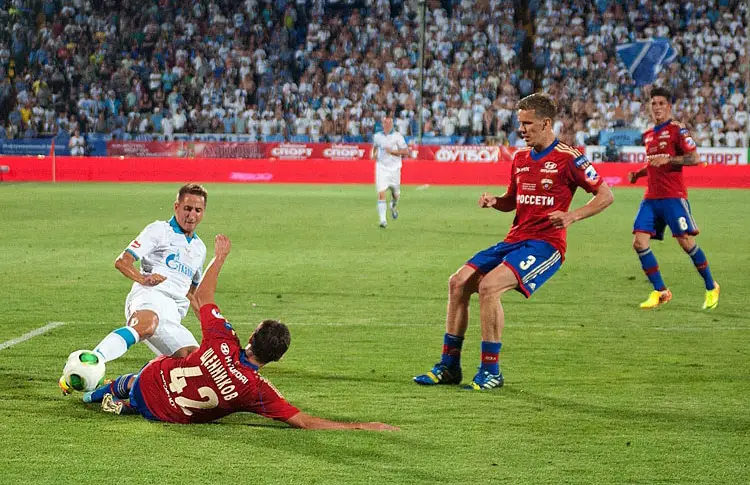
Russian Soccer: An Introductory Guide
Russian soccer caught the world’s attention in 2018, when Russia hosted a very successful FIFA World Cup. The game is Russia’s most popular national sport, ranking just above hockey, and Russia poured millions into new stadiums and renovations on older, Soviet-built stadiums. This construction was made as a point of pride for the Russian government, […]
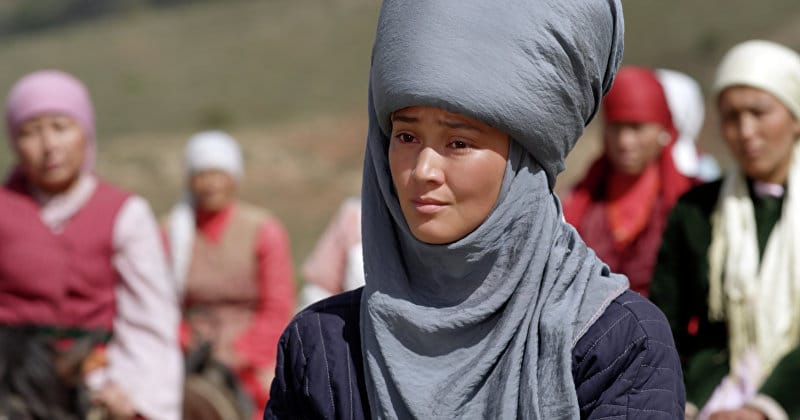
Kurmanjan Datka: American Students Review a Modern Kyrgyz Film
Kurmanjan Datka is a historical drama about a woman who helped unite Kyrgyzstan’s fourty tribes into a nation to fight the invading Russian forces. Recently, a modern film was made of her life and deeds. It is called simply Kurmanjan Datka, although it was released with English subtitles with a second name: Queen of the […]
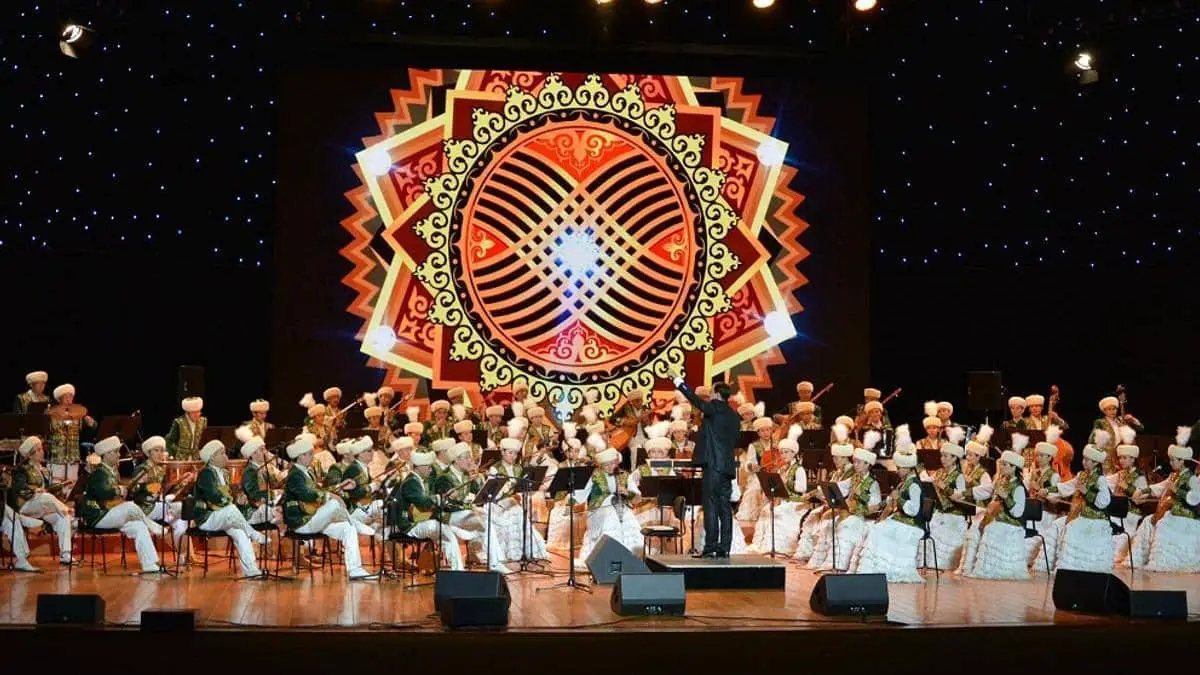
Kambarkan Folk Ensemble
The Kambarkan Folk Ensemble (Камбаркан фольклордук ансамбл) represents a milestone in the cultivation of Kyrgyz national identity. Originally founded in 1987 by artist and musician Chalagyz Isabayev, the ensemble aimed to preserve, appreciate, and explore Kyrgyz folk music. Isabayev, born 1937 in Kyrgyzstan’s Issyk-Kul Region, was an honored artist of the Kyrgyz Republic. Although he […]

Kyrgyz Soccer: An Introductory Guide
The history of soccer in Kyrgyzstan goes back to 1921, with an oft-cited first match taking place in Bishek, Kyrgyzstan’s capital city, against a team from Kazakhstan. The Kazakh team won, but not before the sport of soccer staked a permanent claim on the Kyrgyz national consciousness— the game’s been culturally significant ever since. However, […]

Central Asia’s Got Talent
The London School, where the SRAS students in Bishkek study, is located near a small shopping mall known as the VEFA Center. Due to its proximity, VEFA is where most students do their shopping. It also hosts many rotating attractions, however, in the large presentation space at the main entrance. Sometimes this is marketing for […]




